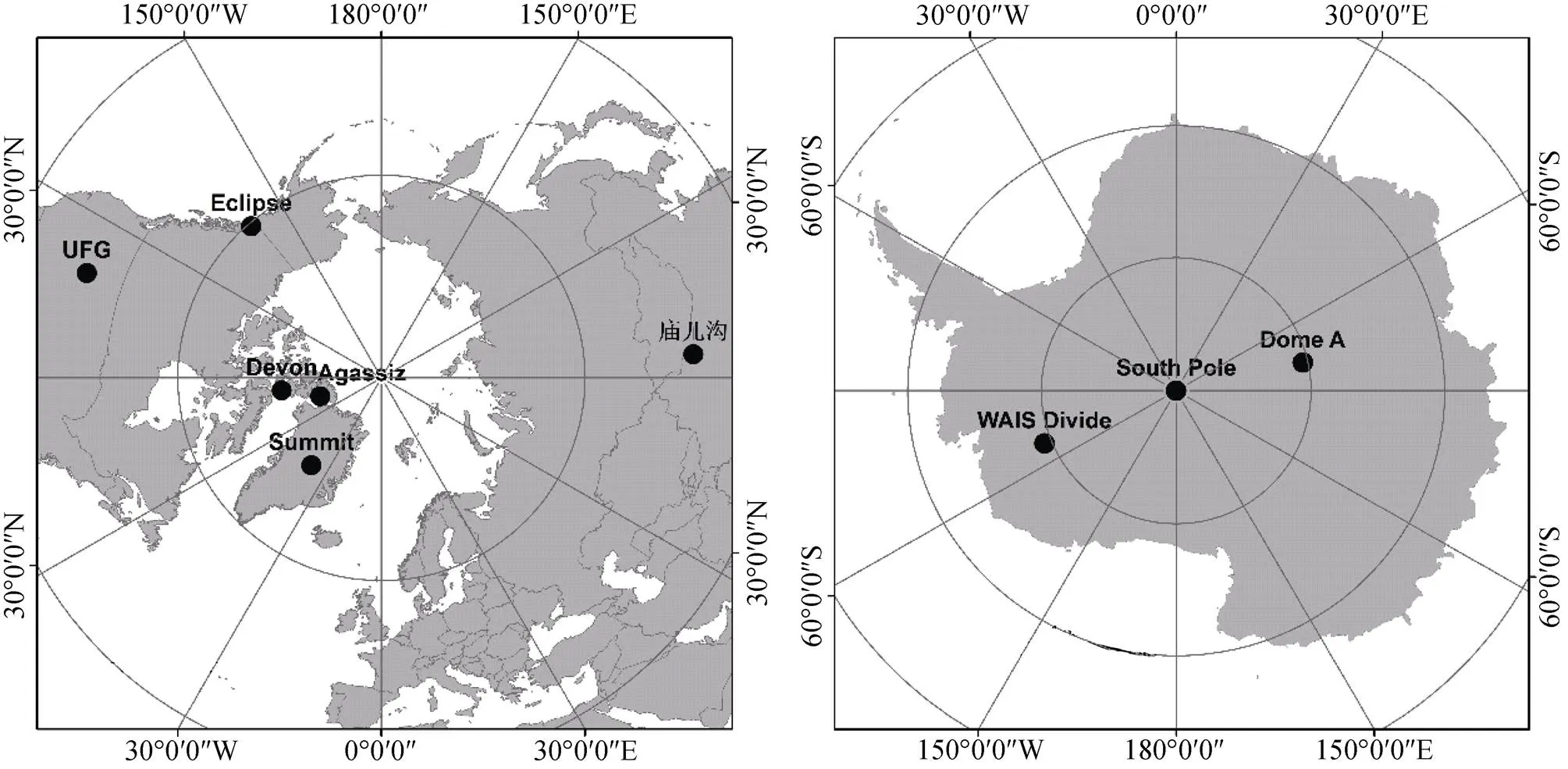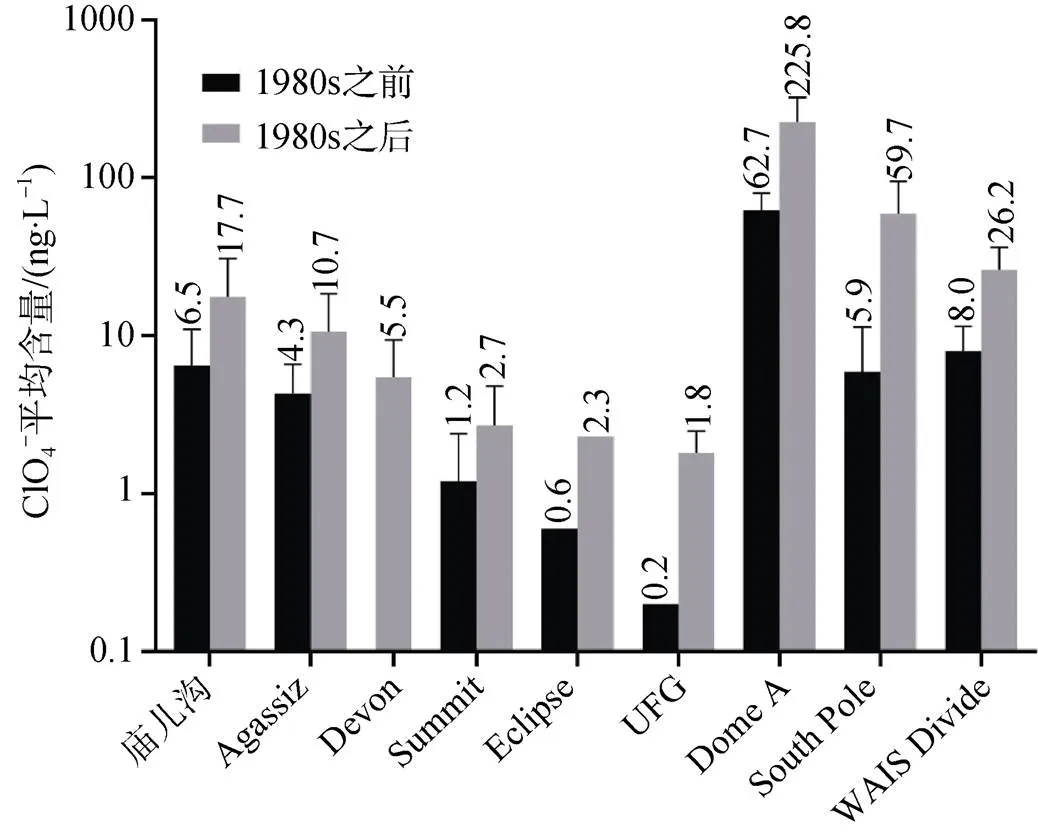极地雪冰中高氯酸盐的研究进展
2021-03-27赵茜姜苏史贵涛陈振楼孙波
赵茜 姜苏 史贵涛, 陈振楼 孙波
研究进展
极地雪冰中高氯酸盐的研究进展
赵茜1,2姜苏1史贵涛2,1陈振楼2孙波1
(1自然资源部极地科学重点实验室, 中国极地研究中心, 上海 200136;2地理信息科学教育部重点实验室, 华东师范大学, 上海 200241)
环境中普遍存在着自然条件下产生的高氯酸盐(ClO4–), 其同位素组成的显著特征(如17O异常和/或36Cl正值)表明这些ClO4–很可能来自于大气平流层且臭氧(O3)参与了其形成过程。极地冰盖是保存大气来源ClO4–的天然档案, 能够提供大气来源ClO4–的含量、空间分布、长时间尺度内的变化序列及不同历史时期的来源等信息。这些信息对于明确人类活动对大气来源ClO4–的影响, 大气中产生ClO4–的机理, 以及大气中ClO4–的产量与大气化学、环境条件之间的关系具有重要意义。在总结了极地雪冰中ClO4–的来源、含量水平、时间变化序列及大气中产生ClO4–的机理等方面的研究进展之后, 提出今后应利用极地雪冰样品研究不同区域ClO4–的大气圈层(平流层、对流层)主要来源, 并开展雪冰中ClO4–的沉积后过程研究, 从而能够更好地理解ClO4–的大气化学过程, 并获取大气中ClO4–的产量及其变化的真实信息。
极地 雪冰 高氯酸盐 来源 产生机理
0 引言
高氯酸盐(ClO4–)是一种持久性无机污染物, 由于其强氧化性和高稳定性被广泛应用于军事、工业以及航空航天等领域[1-3]。痕量水平的ClO4–就能够影响人体甲状腺对于碘离子的吸收[4], 进而危害人体健康[5]。美国是最早对供水系统中ClO4–含量水平开展调查的国家[6], 20世纪90年代, 研究人员在加利福尼亚州的饮用水中检测出了含量高达260µg·L–1的ClO4–[7], 此后多个国家和地区针对于不同环境介质中ClO4–的含量水平开展了广泛的调查。研究表明, ClO4–普遍存在于各种环境介质中, 比如食品和饮料[8-10]、水体[11-15]、土壤[11,16]、大气[17-18]、植物[19-20]、动物[21-22]以及人体血液[23-24]。由于具有极高的水溶性和非挥发性, 进入环境中的ClO4–会随着水流迁移扩散, 进而扩大污染范围[25]。
然而环境中的ClO4–并非都来自于人类活动, 也有在大气中自然产生的[26-28]。智利阿塔卡马沙漠的硝酸盐矿石是已知的富含自然来源ClO4–的典型代表[29], 此外, 在远离人类污染的南极大陆[30-31]、在没有污染源输入的大面积地下水中[32-34]、在北极高海拔冰川[27,35-36]以及在大气湿沉降中[34,37-38]均广泛分布着自然来源的ClO4–[28,39]。极区独特的地理优势与气候条件(远离人类和生物活动频繁的大陆、极低的气温、干燥的空气等)使携带着大气化学成分和气候环境信息的化学物质沉降至冰盖表面, 并按照年代序列保存在极地冰盖上[40-41]。因此极地雪冰是大气来源ClO4–的天然档案, 能够提供大气来源ClO4–的背景值及其在历史时期的变化, 这些信息不仅是制定ClO4–污染防治政策的重要依据, 而且能够为研究大气中产生ClO4–的机理以及ClO4–产量与大气化学、环境条件之间的关系提供重要数据。本文在阐述了极地雪冰中ClO4–研究进展的基础上, 提出了未来可能的研究方向。
1 极地雪冰中ClO4–的来源
通常情况下, ClO4–的生产、使用和处理过程造成的污染仅局限在当地的地表环境和地下水中[36]。尽管来自于人类活动的ClO4–能够进入大气并经由大气环流被输送至其他地区, 但是具有非挥发性质的ClO4–只有吸附在尘埃颗粒上才能够进入大气[42]。研究表明, 尘埃被大气输送至遥远极区的可能性非常小[43], 然而, 在远离人类污染的南极雪冰和沙土中却检测到了高水平的ClO4–[30-31]。针对远离人类活动且/或无污染源输入地区ClO4–的来源, 研究人员展开了系列研究。
早在1996年, 研究人员通过实测发现, 大气平流层中无机氯的总量显著高于3种已知含氯无机化合物(HCl、ClONO2和HOCl)含量的总和, 他们以模式模拟的方式预测平流层内应存在HClO4, 这样才能够解释无机氯总量与已知含氯无机化合物含量之间的差异, 且模拟结果显示HClO4可能是在16~22 km高空中的气溶胶上形成的[44]。此后, Murphy和Thomson[18]对采自于5~19 km高空中的气溶胶进行了检测, 结果证实在平流层底部(距地面约19 km)的硫酸盐气溶胶中确实存在ClO4–。随着高灵敏度检测技术手段的发展, 研究人员依据物质的同位素组成能够准确判断其来源[28,39,45-53], 并获悉物质产生过程的相关信息[26,28,31,45,54-56], Bao和Gu[45]研究发现阿塔卡马沙漠土壤中的ClO4–存在显著的17O异常(通常情况下, O的稳定同位素分馏遵循δ17O≈0.52×δ18O这一线性关系[57], 不遵循上述线性关系的分馏被称为非质量分馏, 用Δ17O=δ17O–0.52×δ18O表示[58]), 且具有较高的Δ17O值(在4.2‰~9.6‰之间), 而人工合成ClO4–的Δ17O值接近于0, 他们提出阿塔卡马沙漠土壤中的ClO4–很可能是大气中的含氯化合物经臭氧(O3)氧化的产物。Jackson等[28]报道了美国加利福尼亚州死谷地区土壤样品中ClO4–的Δ17O值为8.6‰~18.4 ‰, 他们认为该地区土壤中的ClO4–同样来自于有O3参与的大气化学过程。Cl的放射性同位素36Cl在平流层中由宇宙射线照射产生[46], 因此平流层内形成的ClO4–应能够检测到36Cl, 而在对流层或地表形成的ClO4–中几乎检测不到36Cl[47]。Sturchio等[39]检测了不同地区的地下水和沙漠土壤及人工合成的ClO4–中36Cl/ Cl比值, 结果发现美国西南部地区地下水和沙漠土壤中ClO4–的36Cl/Cl比值最高, 在3 100×10–15~28 800×10–15之间, 阿塔卡马沙漠中36Cl/ Cl比值范围为0.9×10–15~590×10–15, 而人工合成的ClO4–中36Cl/Cl比值接近于0, 由此证实了美国西南部地区地下水和沙漠土壤以及阿塔卡马沙漠土壤中的ClO4–存在大气平流层来源。
Furdui和Tomassini[27]研究发现北极Devon冰帽上采集的雪坑中ClO4–具有明显的季节变化, 其含量峰值出现在夏季, 而且这些峰值与其对应的Cl–之间呈现出显著的正相关关系, 由此推测该地区夏季的ClO4–很可能存在对流层来源。同样, 在北极Agassiz冰帽上采集的浅冰芯中也发现了ClO4–与Cl–在1940—1959年间呈现出显著的正相关关系, Furdui等[35]认为此期间的ClO4–很可能来自于对流层的闪电作用。然而, 在西南极WAIS Divide地区的雪坑中, ClO4–的峰值出现在秋季, 且其与Cl–并未表现出明显的相关性[55]。因此, 有必要针对更多地点采集的雪冰样品开展研究, 明确其中是否存在大气对流层来源的ClO4–。
2 极地雪冰中ClO4–的含量水平及时间变化序列
图1给出了在南北两极与高海拔冰川上已开展ClO4–相关研究的站点[27,31,35-36,59-61], 各站点雪冰中ClO4–平均含量的研究结果汇总于图2。从图2中可以看出, 极地雪冰中ClO4–的含量均为ng·L–1级, 显著低于普通环境样品中ClO4–的含量。比如, Smith等[11]对美国Las Vegas Wash流域3个采样点收集的水样进行了检测, 发现其中ClO4–的平均含量可达0.45 mg·L–1。Her等[13]对在韩国周边海域采集的海水样品进行了检测, 其中ClO4–的平均含量为1.15 μg·L–1。Kanan等[15]报道, 来自印度不同地区的地下水样品中ClO4–的平均含量为1.0μg·L–1。
通过对一支采集自加拿大Eclipse地区浅冰芯(其中记录的ClO4–的时间变化序列不连续, 存在含量记录的年代序列分别为1970—1973、1982—1986、1999—2002年)的研究, Rao等[60]首次报道了雪冰中ClO4–含量在1980年之后显著上升的现象。此后, 研究人员依据采集自不同地区的雪冰样品证实了上述结论。Peterson等[62]对北极格陵兰Summit地区采集的一支浅冰芯(记录的年代序列为1950—2006年)的研究结果表明ClO4–在1980年之前的平均含量为(0.8±0.6)ng·L–1, 1980年之后的平均含量为(2.7±2.1)ng·L–1。采集自南极点(South Pole)区域的一支粒雪芯中记录了ClO4–在1920—2005年间的变化序列, 其中ClO4–的含量在1970年之前较低, 1970年之后呈现出上升趋势, 这一上升趋势在20世纪80年代中期开始显著增强; 在东南极冰盖最高点Dome A地区, 积雪中的ClO4–也表现出与上述相同的时间变化序列[31]。
对于ClO4–的这一时间变化趋势, 研究人员试图从其产生机理方面给出解释。Jiang等[31]发现南极South Pole和Dome A雪层中ClO4–的时间变化序列与平流层中等价有效氯(EESC)的变化趋势一致, 认为南极雪冰中的ClO4–很可能来自于平流层。在北极Agassiz地区采集的浅冰芯(记录的年代序列为1936—2007年)中, Furdui等[35]发现ClO4–含量在1979年之后开始上升且在1990年之后呈现出下降的趋势, 他们对比分析了与冰芯记录同时期的有机氯化合物一氟二氯乙烷(HCFC- 141b)和甲基氯仿(CH3CCl3)的排放记录, 发现CH3CCl3与ClO4–的含量变化趋势吻合, 因此认为CH3CCl3很可能是影响Summit地区1980—2000年间大气中ClO4–产量的主要物质。同样, 在北极格陵兰Summit地区采集的时间序列为1700—2007年的冰芯中, Cole-Dai等[36]发现1980年之后ClO4–的平均含量是1980年之前的2—3倍, 且ClO4–的含量在20世纪90年代中期出现略微下降的趋势, 通过对比发现ClO4–与有机氯化合物的变化趋势相似, 他们同样认为人类活动使得ClO4–前体物质——有机氯的排放量增加, 由此导致大气中ClO4–产量在1980年后显著上升; 然而, 冰芯中ClO4–的含量在工业革命前后并未表现出显著差异, 说明始于1850年的工业革命所带来的大范围人类活动并未影响北极格陵兰地区大气中ClO4–的产量。

图1 本文综述的极区雪冰ClO4–研究站点分布图
Fig.1. Locations of snow pit and ice core sites referred to in the text
然而, 南极Dome A和South Pole地区雪层中ClO4–含量随深度的变化趋势与具有沉积后过程的某些化学物质, 如NO3–、Cl–、甲基磺酸(MSA)在雪层中的变化十分相似[63]。研究表明, 在南极低积累率地区(如Dome A和Dome C), 雪层中的NO3–经历了显著的沉积后过程[64], 其含量在表层雪中较高, 随着雪层深度的增加含量逐渐降低, 直至1 m深度处NO3–含量基本保持不变[65-66]。在Dome A地区3 m深雪坑中, ClO4–表现出与NO3–相似的变化趋势, 说明ClO4–很可能也发生了沉积后过程[31]。沉积后过程能够显著改变NO3–在雪冰中的初始含量及其同位素组成[67-68]。如果ClO4–的沉积后过程确实存在, 那么很可能同样会改变其在雪冰中的初始含量及同位素组成, 导致雪冰中测量到的数值无法真实反应ClO4–初始沉降时的情况, 而这些初始沉降信息对于认识和理解大气中ClO4–的产量及大气圈层(平流层、对流层)来源至关重要。因此有必要针对积雪中ClO4–的沉积后过程及机理开展相关研究。
从图2中还可以看出, 南极雪冰中ClO4–的含量明显高于北极(高1~2个数量级)。如前所述, 极地雪冰中的ClO4–主要在大气中自然产生, 其前体物质来自于人类活动排放的含氯化合物, 相对于北极地区而言, 南极受到人类活动的影响更小, 然而南极雪冰中ClO4–含量却更高。目前, 对这一现象的解释还缺乏相关的研究, 需要针对ClO4–的产生机理及其影响因素, 以及两极地区的气候环境差异等因素开展系列研究。

图2 对数标尺表示的不同地区雪冰中ClO4–平均含量. 庙儿沟浅冰芯记录的年代序列为1956—2004[59]; Agassiz浅冰芯为1936—2007[35]; Devon雪坑为1996—2005[27]; Summit冰芯为1700—2007[36]; Eclipse浅冰芯为1970—2002[60]; UFG冰芯为1726—1993[60]; Dome A雪坑为1967—2010[31]; South Pole粒雪芯为19{Rao, 2012 #6}20—2005[31]; WAIS Divide粒雪芯为1929—2002[61]
Fig.2. Average concentrations of ClO4–at different sitespresented in log scale. Ice cores and snow pits cover the time period of 1956—2004 (Miaoergou)[59], 1936—2007 (Agassiz)[35], 1996—2005 (Devon)[27], 1700—2007 (Summit)[36], 1970—2002 (Eclipse)[60], 1726—1993 (UFG)[60], 1967—2010 (Dome A)[31], 1920—2005 (South Pole)[31]and 1929—2002 (WAIS Divide)[61]
综上所述, ClO4–在极地雪冰中的分布具有以下特点: 极地雪冰中ClO4–的含量明显低于普通环境样品中ClO4–的含量, 且北极雪冰中ClO4–的含量比南极雪冰中的含量低1~2个数量级; 同时, 雪冰中记录了1980年之后ClO4–含量显著上升的现象。
3 大气中产生ClO4–的机理
依据环境样品ClO4–中显著的17O异常, 研究人员推测O3很可能参与了ClO4–的生成过程[45]; 此后, 他们通过模拟实验证实了在O3存在的条件下, Cl–、OCl–、ClO2–等前体物质确实能够被氧化成ClO4–[54,69]。Kang等[69]研究了前体物质的固液状态对ClO4–产量的影响, 他们发现水溶液对O3氧化前体物质生成ClO4–的反应有一定抑制作用, 因此液态Cl–生成ClO4–的产量要低于固态Cl–。Rao等[54]进一步研究了溶液中不同的含氯前体物(Cl–、OCl–、ClO2–、ClO3–)被O3氧化生成ClO4–的速率, 发现反应速率取决于初始条件下前体物质的氧化状态, 低氧化状态的OCl–反应速率要低于高氧化状态的ClO2–, 而更高氧化状态的ClO3–则不与O3发生反应; 此外, Cl–虽然能被O3氧化为ClO4–, 但与OCl–和ClO2–相比, 其反应速率低几个数量级。
研究发现在紫外光照射下, OCl–、ClO2–、ClO3–也能够生成ClO4–[70-71]。Kang等[70]通过模拟实验研究了不同初始浓度的Cl–、OCl–、ClO2–、ClO3–溶液在紫外光(λ = 253. 7nm)和太阳光照射下生成ClO4–的速率, 结果表明Cl–溶液在紫外光和太阳光照射下均不能生成ClO4–, 而紫外光可将浓度高达10 000mg L–1的OCl–、ClO2–、ClO3–转化为ClO4–; 用太阳光和紫外光分别照射浓度为100 mg·L–1的ClO2–时, ClO4–的产量相当。Kang等[71]进一步研究了液态ClO2–在紫外光照射下产生ClO4–的反应过程, 他们发现紫外光波长和前体物质ClO2–的初始含量均能够显著影响ClO4–的产量; 当分别使用波长为253.7 nm、300 nm和350 nm的紫外光照射初始含量为15 mM的ClO2–溶液时, 在300 nm和350 nm的紫外光照射下ClO4–的产量是在253.7 nm照射下的5倍, 这主要是因为较长的波长有利于ClO4–产生过程中关键中间产物的生成; 而使用波长为253.7 nm的紫外光分别照射初始含量为15 mM和150 mM的ClO2–溶液, ClO4–的最大产量分别为1 μM和100 μM。
此外, 研究人员发现对流层中的闪电也能够促进大气中ClO4–的产生。Dasgupta等[26]首次报道了实验室模拟的放电条件下, NaCl气溶胶能够转化为ClO4–。Parker等[34]对同一采样点不同时段的雨水进行了长期观测, 发现在雷电交加的暴风雨天气条件下收集的雨水样品中ClO4–的检出率较其他气候条件下的样品高。Rao等[72]对不同湿度条件下的含Cl–气溶胶进行模拟放电实验, 研究得出外加电压的增加有利于ClO4–产生, 外加电压从10 kV升高到24 kV时, ClO4–的产量从0.5 μg增加到4.8 μg; 而水分的存在会抑制ClO4–的产生, 当相对湿度从~46%增加到~62%时, ClO4–的产量从(2.8±0.1)μg降低到(0.9±0.1)μg。然而, 对于火山喷发作用能否影响大气中ClO4–的产量, 研究人员们却没有形成统一意见。在北极Agassiz冰芯中, Furdui等[35]发现火山事件与ClO4–含量之间不存在任何相关性, 他们认为火山活动不会导致北极Agassiz地区ClO4–的产量增加。而在北极格陵兰Summit地区钻取的一支记录过去300年气候记录的冰芯中, Cole-Dai等[36]发现在大规模火山喷发期间, ClO4–的含量均出现峰值, 他们认为火山喷发向平流层注入了大量硫酸盐气溶胶, 从而影响了大气中ClO4–的产量, 但是对于火山活动如何影响ClO4–生成的具体过程尚不清楚。
4 讨论与展望
目前, 研究人员对ClO4–的大气平流层来源已达成共识, 尚未明确其对流层来源, 依据不同地区雪冰样品重建的大气来源ClO4–的季节变化规律存在差异, 对ClO4–的大气化学过程及其影响因素的认识也尚不全面。此外, 沉积后过程很可能导致雪冰中测量的ClO4–含量及其同位素组成无法真实反应其初始沉降时的情况, 这些初始沉降信息对于认识和理解大气中ClO4–的产量、时间变化、产生机理以及来源等至关重要, 而文献中尚未见有关ClO4–沉积后过程的研究报道。极地冰盖是保存大气中自然产生ClO4–的天然档案, 利用极地雪冰样品有望获取ClO4–的大气圈层(平流层、对流层)来源、产生机理及影响大气中ClO4–产量的因素等方面信息, 并可以开展ClO4–沉积后过程及其影响因素的研究。这些研究工作取得的成果有助于人们理解ClO4–的大气化学过程与沉积后过程, 并获取大气中ClO4–产量及其变化的真实信息。
1 FOURNIER E W, BRADY B B. Perchlorate leaching from solid rocket motor propellant in water[J]. Journal of Propulsion and Power, 2005, 21(5): 937-941.
2 MOTZER W E. Perchlorate: problems, detection, and solutions[J]. Environmental Forensics, 2001, 2(4): 301-311.
3 URBANSKY E T. Perchlorate chemistry: Implications for analysis and remediation[J]. Bioremediation Journal, 1998, 2(2): 81-95.
4 KIRK A B. Environmental perchlorate: why it matters[J]. Analytica Chimica Acta, 2006, 567(1): 4-12.
5 STEINMAUS C M. Perchlorate in water supplies: Sources, exposures, and health effects[J]. Current Environment Health Reports, 2016, 3(2): 136-143.
6 方齐乐, 陈宝梁.新型环境污染物高氯酸盐的环境化学行为、食品安全及健康风险[J]. 科学通报, 2013, 58(26): 2626-2642.
7 WAGNER H P, SUAREZ F X, PEPICH B V, et al. Challenges encountered in extending the sensitivity of US Environmental Protection Agency Method 314.0 for perchlorate in drinking water[J]. Journal of Chromatography A, 2004, 1039(1/2): 97-104.
8 KIRK A B, MARTINELANGO P K, TIAN K, et al. Perchlorate and iodide in dairy and breast milk[J]. Environmental Science & Technology, 2005, 39(7): 2011-2017.
9 EL ARIBI H, LE BLANC Y J, ANTONSEN S, et al. Analysis of perchlorate in foods and beverages by ion chromatography coupled with tandem mass spectrometry (IC-ESI-MS/MS)[J]. Analytica Chimica Acta, 2006, 567(1): 39-47.
10 SHI Y L, ZHANG P, WANG Y W, et al. Perchlorate in sewage sludge, rice, bottled water and milk collected from different areas in China[J]. Environment International, 2007, 33(7): 955-962.
11 SMITH P N, YU L, MCMURRY S T, et al. Perchlorate in water, soil, vegetation, and rodents collected from the Las Vegas Wash, Nevada, USA[J]. Environmental Pollution, 2004, 132(1): 121-127.
12 BACKUS S M, KLAWUUN P, BROWN S, et al. Determination of perchlorate in selected surface waters in the Great Lakes Basin by HPLC/MS/MS[J]. Chemosphere, 2005, 61(6): 834-843.
13 HER N, JEONG H, KIM J, et al. Occurrence of perchlorate in drinking water and seawater in South Korea[J]. Archives of Environmental Contamination and Toxicology, 2011, 61(2): 166-172.
14 ERDEMGIL Y, Gözet T, Can Ö, et al. Perchlorate levels found in tap water collected from several cities in Turkey[J]. Environmental Monitoring and Assessment, 2016, 188(3): 1-7.
15 Kannan K, Praamsma M L, Oldi J F, et al. Occurrence of perchlorate in drinking water, groundwater, surface water and human saliva from India[J]. Chemosphere, 2009, 76(1): 22-26.
16 Gan Z, Sun H, Wang R, et al.Occurrence and exposure evaluation of perchlorate in outdoor dust and soil in mainland China[J]. Science of the Total Environment, 2014, 470-471: 99-106.
17 Shi Y L, Zhang N, Gao J M, et al. Effect of fireworks display on perchlorate in air aerosols during the Spring Festival[J]. Atmospheric Environment, 2011, 45(6): 1323-1327.
18 Murphy D M, Thomson D S. Halogen ions and NO+in the mass spectra of aerosols in the upper troposphere and lower stratosphere[J]. Geophysical Research Letters, 2000, 27(19): 3217-3220.
19 Ellington J J, Wolfe N L, Garrison A W, et al. Determination of perchlorate in tobacco plants and tobacco products[J]. Environmental Science & Technology, 2001, 35(15): 3213-3218.
20 Urbansky E T, Magnuson M L, Kelty C A, et al. Perchlorate uptake by salt cedar (Tamarix ramosissima) in the Las Vegas Wash riparian ecosystem[J]. Science of the Total Environment, 2000, 256(2/3): 227-232.
21 Cheng Q Q, Perlmutter L, Smith P N, et al. A study on perchlorate exposure and absorption in beef cattle[J]. Journal of Agricultural and Food Chemistry, 2004, 52(11): 3456-3461.
22 Dodds E D, Kennish J M, Hippel F A, et al. Quantitative analysis of perchlorate in extracts of whole fish homogenates by ion chromatography: Comparison of suppressed conductivity detection and electrospray ionization mass spectrometry[J]. Analytical and Bioanalytical Chemistry, 2004, 379(5/6): 881-887.
23 Zhang T, Wu Q, Sun H W, et al. Perchlorate and iodide in whole blood samples from infants, children, and adults in Nanchang, China[J]. Environmental Science & Technology, 2010, 44(18): 6947-6953.
24 Oldi J F, Kannan K. Perchlorate in human blood serum and plasma: Relationship to concentrations in saliva[J]. Chemosphere, 2009, 77(1): 43-47.
25 Tipton D K, Rolston D E, Scow K M. Transport and biodegradation of perchlorate in soils[J]. Journal of Environmental Quality, 2003, 32(1): 40-46.
26 Dasgupta P K, Martinelango P K, Jackson W A, et al. The origin of naturally occurring perchlorate: the role of atmospheric processes[J]. Environmental Science & Technology, 2005, 39(6): 1569-1575.
27 Furdui V I, Tomassini F. Trends and sources of perchlorate in Arctic snow[J]. Environmental Science & Technology, 2010, 44(2): 588-592.
28 Jackson W A, BÖhlke J K, Gu B, et al. Isotopic composition and origin of indigenous natural perchlorate and co-occurring nitrate in the southwestern United States[J]. Environmental Science & Technology, 2010, 44(13): 4869-4876.
29 Calderón R, Palma P, Parker D, et al. Perchlorate levels in soil and waters from the Atacama desert[J]. Archives of Environmental Contamination and Toxicology, 2014, 66(2): 155-161.
30 Kounaves S P, Stroble S T, Anderson R M, et al. Discovery of natural perchlorate in the Antarctic Dry Valleys and its global implications[J]. Environmental Science & Technology, 2010, 44(7): 2360-2364.
31 Jiang S, Cox T S, Cole-Dai J, et al. Trends of perchlorate in Antarctic snow: Implications for atmospheric production and preservation in snow[J]. Geophysical Research Letters, 2016, 43(18): 9913-9919.
32 Plummer L N, Böhlke J K, Doughten M W. Perchlorate in Pleistocene and Holocene groundwater in north-central New Mexico[J]. Environmental Science & Technology, 2006, 40(6): 1757-1763.
33 Rajagopalan S, Anderson T A, Fahlquist L, et al. Widespread presence of naturally occurring perchlorate in high plains of Texas and New Mexico[J]. Environmental Science & Technology, 2006, 40(10): 3156-3162.
34 Parker D R, Seyfferth A L, Reese B K. Perchlorate in groundwater: A synoptic survey of “pristine” sites in the coterminous United States[J]. Environmental Science & Technology, 2008, 42(5): 1465-1471.
35 Furdui V I, Zheng J C, Furdui A. Anthropogenic perchlorate increases since 1980 in the Canadian high Arctic[J]. Environmental Science & Technology, 2018, 52(3): 972-981.
36 Cole-Dai J, Peterson K M, Kennedy J A, et al. Evidence of influence of human activities and volcanic eruptions on environmental perchlorate from a 300-year Greenland ice core record[J]. Environmental Science & Technology, 2018, 52(15): 8373-8380.
37 Rajagopalan S, Anderson T, Cox T S, et al. Perchlorate in wet deposition across north America[J]. Environmental Science & Technology, 2009, 43(3): 616-622.
38 Barron L, Nesterenko P N, Paull B. Rapid on-line preconcentration and suppressed micro-bore ion chromatography of part per trillion levels of perchlorate in rainwater samples[J]. Analytica Chimica Acta, 2006, 567(1): 127-134.
39 Sturchio N C, Caffee M, Beloso A D, et al. Chlorine-36 as a tracer of perchlorate origin[J]. Environmental Science & Technology, 2009, 43(18): 6934-6938.
40 Legrand M, Mayewski P. Glaciochemistry of polar ice cores: A review[J]. Reviews of Geophysics, 1997, 35(3): 219-243.
41 Delmas R J. Environmental information from ice cores[J]. Reviews of Geophysics, 1992, 30(1): 1-21.
42 Vella A J, Chircop C, Micallef T, et al. Perchlorate in dust fall and indoor dust in Malta: An effect of fireworks[J]. Science of the Total Environment, 2015, 521: 46-51.
43 Maher B A, Prospero J M, Mackie D, et al. Global connections between aeolian dust, climate and ocean biogeochemistry at the present day and at the last glacial maximum[J]. Earth Science Reviews, 2010, 99(1/2): 61-97.
44 Jaeglé L, Yung Y L, Toon G C, et al. Balloon observations of organic and inorganic chlorine in the stratosphere: The role of HClO4production on sulfate aerosols[J]. Geophysical Research Letters, 1996, 23(14): 1749-1752.
45 Bao H m, Gu B h. Natural perchlorate has a unique oxygen isotope signature[J]. Environmental Science & Technology, 2004, 38(19): 5073-5077.
46 LAL D, PETERS B. Cosmic ray produced radioactivity on the earth[M]//Kosmische Strahlung II/Cosmic Rays II. Berlin, Heidelberg: Springer Berlin Heidelberg, 1967: 551-612.
47 PHILLIPS F M. Chlorine-36[M]//Environmental tracers in subsurface hydrology. Boston, MA: Springer, 2000: 299-348.
48 Sturchio N C, Böhlke J K, Gu B H, et al. Isotopic tracing of perchlorate in the environment[M]//Handbook of environmental isotope geochemistry. Berlin, Heidelberg: Springer Berlin Heidelberg, 2012: 437-452.
49 Böhlke J K, Sturchio N C, Gu B H, et al. Perchlorate isotope forensics[J]. Analytical Chemistry, 2005, 77(23): 7838-7842.
50 Sturchio N C, Böhlke J K, Gu B H, et al. Stable isotopic composition of chlorine and oxygen in synthetic and natural perchlorate[M]//Perchlorate. Boston MA: Springer, 2006: 93-109.
51 Motzer W E, Mohr T K, McCraven S, et al. Stable and other isotope techniques for perchlorate source identification[J]. Environmental Forensics, 2006, 7(1): 89-100.
52 Duncan P B, Morrison R D, Vavricka E. Forensic identification of anthropogenic and naturally occurring sources of perchlorate[J]. Environmental Forensics, 2005, 6(2): 205-215.
53 Poghosyan A, Morel-Espinosa M, Valentin-Blasini L, et al. Chlorine isotopic composition of perchlorate in human urine as a means of distinguishing among exposure sources[J]. Journal of Exposure Science and Environmental Epidemiology, 2016, 26(3): 324.
54 Rao B, Anderson T A, Redder A, et al. Perchlorate Formation by ozone oxidation of aqueous chlorine/oxy-chlorine species: Role of ClxOyRadicals[J]. Environmental Science & Technology, 2010, 44(8): 2961-2967.
55 Crawford T Z, Kub A D, Peterson K M, et al. Reduced perchlorate in West Antarctica snow during stratospheric ozone hole[J]. Antarctic Science, 2017, 29(3): 292-296.
56 Jackson W A, Anderson T, Harvey G, et al. Occurrence and formation of non-anthropogenic perchlorate[M]//Perchlorate. Boston MA: Springer, 2006: 49-69.
57 Matsuhisa Y, Goldsmith J R, Clayton R N. Mechanisms of hydrothermal crystallization of quartz at 250℃ and 15 kbar[J]. Geochimica et Cosmochimica Acta, 1978, 42(2): 173-182.
58 Thiemens M H, Savarino J, Farquhar J, et al. Mass-independent isotopic compositions in terrestrial and extraterrestrial solids and their applications[J]. Accounts of Chemical Research, 2001, 34(8): 645-652.
59 Du Z h, Xiao C d, Furdui V I, et al. The perchlorate record during 1956–2004 from Tienshan ice core, East Asia[J]. Science of the Total Environment, 2019, 656: 1121-1132.
60 Rao B A, Wake C P, Anderson T, et al. Perchlorate depositional history as recorded in north American ice cores from the eclipse icefield, Canada, and the upper Fremont glacier, USA[J]. Water, Air, & Soil Pollution, 2012, 223(1): 181-188.
61 Cox T S. Investigating the atmospheric production of perchlorate: Inference from polar ice cores[D]. Vermillion: South Dakota State University, 2017.
62 Peterson K M, Cole-Dai J, Brandis D L, et al. Assessment of anthropogenic contribution to perchlorate in the environment using an ice core record[M]//ACS Symposium Series. Washington, DC: American Chemical Society, 2015: 175-185.
63 Wagnon P, Delmas R J, Legrand M. Loss of volatile acid species from upper firn layers at Vostok, Antarctica[J]. Journal of Geophysical Research: Atmospheres, 1999, 104(D3): 3423-3431.
64 AN C L, WANG Y T, HOU S G. Glaciological observations at Dome Argus, East Antarctica[J]. Advances in Polar Science, 2017, 28(4): 245-255.
65 Shi G T, Buffen A M, Hastings M G, et al. Investigation of post-depositional processing of nitrate in East Antarctic snow: Isotopic constraints on photolytic loss, re-oxidation, and source inputs[J]. Atmospheric Chemistry and Physics, 2015, 15(16): 9435-9453.
66 Shi G T, Hastings M G, Yu J H, et al. Nitrate deposition and preservation in the snowpack along a traverse from coast to the ice sheet summit (Dome A) in East Antarctica[J]. The Cryosphere, 2018, 12(4): 1177-1194.
67 Frey M M, Savarino J, Morin S, et al. Photolysis imprint in the nitrate stable isotope signal in snow and atmosphere of East Antarctica and implications for reactive nitrogen cycling[J]. Atmospheric Chemistry and Physics, 2009, 9(22): 8681-8696.
68 Erbland J, Vicars W C, Savarino J, et al. Air-snow transfer of nitrate on the East Antarctic Plateau-Part 1: Isotopic evidence for a photolytically driven dynamic equilibrium in summer[J]. Atmospheric Chemistry and Physics, 2013, 13(13): 6403-6419.
69 Kang N, Jackson W A, Dasgupta P K, et al. Perchlorate production by ozone oxidation of chloride in aqueous and dry systems[J]. Science of the Total Environment, 2008, 405(1/2/3): 301-309.
70 Kang N, Anderson T A, Jackson W A. Photochemical formation of perchlorate from aqueous oxychlorine anions[J]. Analytica Chimica Acta, 2006, 567(1): 48-56.
71 Kang N, Anderson T A, Rao B, et al. Characteristics of perchlorate formation via photodissociation of aqueous chlorite[J]. Environmental Chemistry, 2009, 6(1): 53-59.
72 Rao B, Mohan S, Neuber A, et al. Production of perchlorate by laboratory simulated lightning process[J]. Water, Air, & Soil Pollution, 2012, 223(1): 275-287.
REVIEW OF PERCHLORATE RESEARCH IN POLAR SNOW AND ICE
Zhao Qian1,2, Jiang Su1, Shi Guitao2,1, Chen Zhenlou2, Sun Bo1
(1Ministry of Natural Resources Key Laboratory for Polar Science, Polar Research Institute of China, Shanghai 200136, China;2Key Laboratory of Geographic Information Science (Ministry of Education), East China Normal University, Shanghai 200241, China)
Natural perchlorate (ClO4−) is widespread in the natural environment. Its isotopic composition (e.g.,17O anomaly and/or positive36Cl value) indicates that it probably comes from the stratosphere, and ozone (O3) is likely involved in its formation process. Polar ice sheets provide unique samples for the study of natural perchlorate. Snow and ice can provide chronological records indicating past perchlorate levels and spatial variability, and past and present primary perchlorate sources. This is important for understanding the influence of human activities on atmospheric perchlorate production and the relationships between atmospheric perchlorate production, atmospheric chemistry and environmental conditions. In this study, we reviewed the most recent findings in perchlorate research in polar snow, including findings on perchlorate sources, levels, trends, and production mechanism. We identified areas for future research. They include the dominant atmospheric (stratospheric or tropospheric) sources of perchlorate at different locations and the post-depositional processes of perchlorate in snow. Research results will contribute towards improving our understanding of the atmospheric chemistry of perchlorate and atmospheric perchlorate production and variability.
polar regions, snow and ice, perchlorate, source, formation mechanism
2020年1月收到来稿, 2020年2月收到修改稿
国家自然科学基金面上项目(41476169, 41576190)、国家自然科学基金优秀青年基金(41922046)资助
赵茜, 女, 1996年生。硕士, 主要从事雪冰化学研究。E-mail: zhaoqian@pric.org.cn
姜苏, E-mail:jiangsu@pric.org.cn
10. 13679/j.jdyj.20200001
